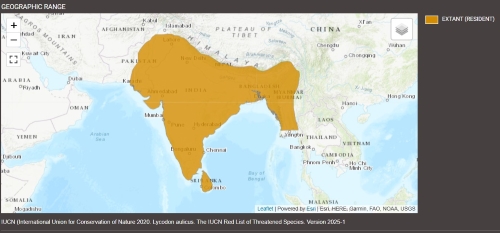Lycodon aulicus, which is also commonly known as Indian Wolf Snakes or common wolf snakes. Indian Wolf Snakes are a species of nonvenomous snake’s family, which is commonly found throughout India and is the most widespread species of snake found in India. Apart from India, this species of snake is also commonly seen in South Asia and Southeast Asia. In this article, we will explore the Indian Wolf Snake, its identification, its habitat, and what makes it different from other Wolf snakes.
.jpg)
Source: inaturalist.org
Taxonomy of the Indian Wolf Snake with its description
The Indian Wolf Snake is scientifically named Lycodon aulicus. Here's the complete classification table:
| Taxonomic Rank | Name | Description |
| Kingdom | Animalia | Multicellular, heterotrophic organisms |
| Phylum | Chordata | Animals with a notochord, dorsal nerve cord, and pharyngeal slits |
| Class | Reptilia | Cold-blooded, scaly-skinned vertebrates that lay eggs |
| Order | Squamata | Includes lizards and snakes; characterized by movable quadrate bones |
| Family | Colubridae | Largest snake family; mostly non-venomous and diverse |
| Genus | Lycodon | Commonly called wolf snakes, mimic venomous snakes like kraits in appearance |
| Species | Lycodon aulicus | Indian Wolf Snake — slender, non-venomous, nocturnal, and often mistaken for kraits |
As per IUCN (International Union for Conservation of Nature 2020), Lycodon aulicus, which is commonly known as the Indian Wolf Snake, comes in the IUCN Red List of Threatened Species.
What are the characteristics of Indian Wolf Snakes?
The Indian Wolf Snake (Lycodon aulicus) comes from a non-venomous family and is widely known for its krait-like appearance. All its characteristics are given below in the table:
| Characteristics | Details |
| Common Name | Indian Wolf Snake |
| Appearance | Shiny, dark brown or black body with white or yellowish crossbars |
| Behavior | Nocturnal, mildly aggressive when disturbed |
| Venom | Non-venomous |
| Diet | Feeds on small lizards and frogs |
| Habitat | Found in forests, agricultural lands, and sometimes human settlements |
| Distribution | Widely distributed across India and parts of Southeast Asia |
| Mimicry | Mimics the highly venomous Bungarus (kraits) to deter predators |
Where are Indian Wolf Snakes found in India?
Indian Wolf Snakes are found in various states of India, including Andhra Pradesh, Assam, Bihar, Chhattisgarh, Goa, Gujarat, Haryana, Himachal Pradesh, Jharkhand, Karnataka, Kerala, Madhya Pradesh, Maharashtra, Meghalaya, Odisha, Punjab, Rajasthan, Tamil Nadu, Telangana, Uttar Pradesh, Uttarakhand, West Bengal, Chandigarh, Dadra and Nagar Haveli, Jammu and Kashmir, Daman and Diu, Delhi, Puducherry, and Mizoram.

Source: iucnredlist.org
How Is The Indian Wolf Snake Different From Other Wolf Snakes?
| Common Name | Scientific Name | Distribution | Color Pattern & Markings | Notable Features |
| Barred Wolf Snake | Lycodon striatus | Throughout India | Jet-black dorsal with white or yellowish bands | Often mistaken for kraits; very similar to dark forms of L. aulicus |
| Flowery/Slender Wolf Snake | Lycodon anamallensis | Southern India (hilly forests) and Sri Lanka | Yellowish-white bands; lacks collar behind neck | Also called the Slender Wolf Snake |
| Travancore Wolf Snake | Lycodon travancoricus | Western Ghats | Bright yellow bands; collar is faint or absent | Endemic to the Western Ghats |
| Vellore Bridal Snake | Lycodon nympha | Kerala to Eastern Ghats (TN, Andhra Pradesh, Odisha) | Grey-brown body with thick yellow bands | Bands are thicker than other wolf snakes |
| Scarce Bridal Snake | Lycodon gracilis | Rarely seen; Kerala to Eastern Ghats | Yellowish, thick bands similar to L. nympha | Rare species; closely resembles the Vellore Bridal Snake |
| Yellow-Spotted Wolf Snake | Lycodon flavomaculatus | Western Ghats | Jet-black dorsal with bright yellow spots | Distinct spotted pattern |
| Yellow-Collared Wolf Snake | Lycodon flavicollis | Western Ghats | The specimen exhibits a greyish-brown body, a prominent thick yellow collar located behind its neck, and body bands that are either indistinct or absent. | The collar stands out as the most prominent characteristic. |
Conclusion
The Indian Wolf Snake (Lycodon aulicus) stands out among its relatives due to its wider distribution, distinct mimicry behaviour, and variable colouration. While many other wolf snakes, like the Barred Wolf Snake or Yellow-Collared Wolf Snake, resemble it in appearance, the Indian Wolf Snake is more widespread, commonly seen even in urban settlements, and more frequently confused with kraits due to its colouration and defensive posture. In contrast, other species often have limited ranges, like those confined to the Western Ghats or Eastern Ghats, and possess more consistent banding patterns or unique collars. Ultimately, the Indian Wolf Snake’s adaptability, mimicry, and frequency of sightings make it the most familiar and identifiable wolf snake species across the Indian subcontinent.
Comments
All Comments (0)
Join the conversation